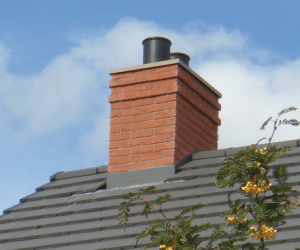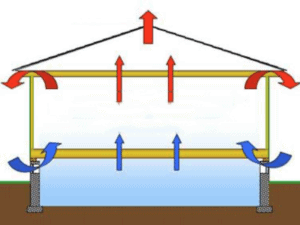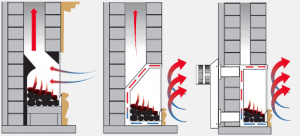 A chimney is a vital part of any gas fire or stove installation. It’s a structure that provides ventilation for hot flue gases and smoke from your fire, to the outside atmosphere.
A chimney is a vital part of any gas fire or stove installation. It’s a structure that provides ventilation for hot flue gases and smoke from your fire, to the outside atmosphere.
But that’s where things certainly don’t stop. There is a lot of science behind chimneys, stoves and how your home keeps warm (or stays cold!)
This article outlines a number of factors, which can impact on how a stove or fire performs, and gives a brief insight into the science of heating and airflow in a home, and how a high efficiency stove, such as an Ecodesign ready stove performs, to keep you warm.
 Your Home – Air is constantly moving around your home, sometimes you can feel it, other times not so much. But it’s always moving. Your house is effectively a system in it’s own right. Airflow tries to escape from the upper part of a home, while at the same time in the lower parts of your house, air tries to force it’s way in.
Your Home – Air is constantly moving around your home, sometimes you can feel it, other times not so much. But it’s always moving. Your house is effectively a system in it’s own right. Airflow tries to escape from the upper part of a home, while at the same time in the lower parts of your house, air tries to force it’s way in.
There are a number of factors, which impact on the airflow in your home, such as your stove (which of course will be from Charlton & Jenrick!), the stack effect (colder air moving in, warmer air moving out), wind loading (the force of wind on a structure) along with a number of other things.
Homes built in the last 20 years tend to be quite airtight, which means it’s harder for cooler air to enter, so the warm air already in the home will rise, but with much less cooler air entering in the lower parts of the home.
But what does all this mean in terms of heating and efficiency? The science gets even more interesting……
The Neutral Pressure Plane – As a result of the stack effect – cooler air in, warmer air out, there is a “level” of neutral pressure inside a house, which sits between the positive pressure that causes heat loss by “pushing” heat out through walls, gaps and windows, and the negative pressure that causes cooler air to be drawn in to a home.
In simple terms – If part of your home is above the plane it will be pushing heat out, if part of your home is below the plane it will be drawing more cooler air in to differing degrees.
Varying conditions will have an impact on the location of the NPP. If a fire or stove, which uses a chimney is below the NPP, air will tend to flow into the house through the chimney or vent. This is called a downdraft. A solution to this is usually to fit a cowl, which sits on the top of a chimney to stop this problem. Positive pressure in a home can cause more of an updraft in a chimney.
Wind loading – Altering interior air pressure caused by the wind is known as wind loading. When wind hits a building, it produces high pressure on the side that it hits, and low pressure on the downwind (direction wind is blowing) side.
Any windows or doors that are on the windward (facing the wind), side will help pressurise the home, which will increase chimney updraft. However, if any windows or doors are open on the downwind (leeward) side, this will depressurise the home, and can cause downdrafts in chimneys and vents.
.
Other household equipment – Things like kitchen fans, tumble dryers all create a negative pressure in a home, by removing large quantities of air, which in turn helps draw in cooler air.

The flow of air in a stove and chimney – Think of smoke going up the chimney as someone drinking from a straw, where the heat of the fire is equivalent to how hard someone sucks on a straw. The physics are pretty much the same. A fire will draw air from the room into the firebox, to continue the burn and produce heat, before waste gases go up the chimney. The hotter the fire, the greater the draw of air from the room will be. The hotter fire will also produce hotter gases, which are lighter, and therefore will exit the chimney even quicker. A stove produces a negative pressure in a home, which is governed by how hot the fire is. A taller chimney, up to a certain height will assist with this negative pressure.
Negative pressure as you can imagine isn’t really that good when you want to stay warm….
But what about high efficiency stoves?
 High efficiency stoves, which have a closed front will significantly reduce the amount of air sucked from a room, with professionals suggesting a high efficiency stove using 12 times less air than an open fire.
High efficiency stoves, which have a closed front will significantly reduce the amount of air sucked from a room, with professionals suggesting a high efficiency stove using 12 times less air than an open fire.
This is a reason why they are so efficient….
While an inefficient open fire will suck lots of mostly warm air from a room, an Ecodesign stove will make efficient use of the air it has. So although it will still consume some air from the room, the amount is limited, which in turn will reduce negative pressure, which will mean less cooler air being sucked into a home.
The end result – a warmer home, heated in a much more efficient way.
The efficiency of an open fire is around 20%. The efficiency of an ecodesign stove is around 80% – so you can see the huge efficiency gains that can be achieved by a more intelligent use of heating.
View our full Ecodesign Ready range at – https://www.charltonandjenrick.co.uk/products/stoves/








